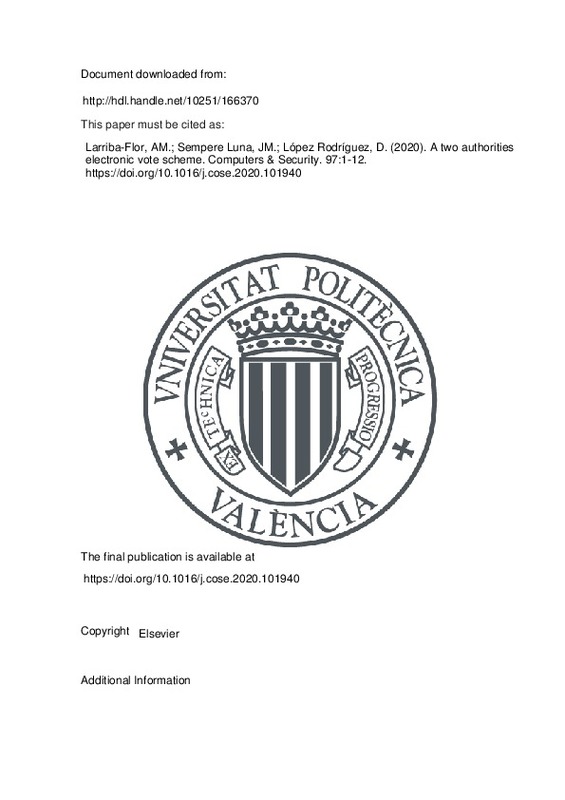Bloom, B. H. (1970). Space/time trade-offs in hash coding with allowable errors. Communications of the ACM, 13(7), 422-426. doi:10.1145/362686.362692
Brams S., Fishburn P.C.. 2007. Approval voting Springer Science
Carroll, T. E., & Grosu, D. (2009). A secure and anonymous voter-controlled election scheme. Journal of Network and Computer Applications, 32(3), 599-606. doi:10.1016/j.jnca.2008.07.010
[+]
Bloom, B. H. (1970). Space/time trade-offs in hash coding with allowable errors. Communications of the ACM, 13(7), 422-426. doi:10.1145/362686.362692
Brams S., Fishburn P.C.. 2007. Approval voting Springer Science
Carroll, T. E., & Grosu, D. (2009). A secure and anonymous voter-controlled election scheme. Journal of Network and Computer Applications, 32(3), 599-606. doi:10.1016/j.jnca.2008.07.010
Chaum, D. L. (1981). Untraceable electronic mail, return addresses, and digital pseudonyms. Communications of the ACM, 24(2), 84-90. doi:10.1145/358549.358563
Cramer, R., Gennaro, R., & Schoenmakers, B. (1997). A secure and optimally efficient multi-authority election scheme. European Transactions on Telecommunications, 8(5), 481-490. doi:10.1002/ett.4460080506
Desmedt, Y. G. (2010). Threshold cryptography. European Transactions on Telecommunications, 5(4), 449-458. doi:10.1002/ett.4460050407
Elgamal, T. (1985). A public key cryptosystem and a signature scheme based on discrete logarithms. IEEE Transactions on Information Theory, 31(4), 469-472. doi:10.1109/tit.1985.1057074
Juang, W.-S. (2002). A Verifiable Multi-Authority Secret Election Allowing Abstention from Voting. The Computer Journal, 45(6), 672-682. doi:10.1093/comjnl/45.6.672
Menezes A., van Oorschot P.C., Vanstone S.A.. 1996. Handbook of Applied Cryptography.
Parhami, B. (1994). Voting algorithms. IEEE Transactions on Reliability, 43(4), 617-629. doi:10.1109/24.370218
Rabin, M. O. (1980). Probabilistic Algorithms in Finite Fields. SIAM Journal on Computing, 9(2), 273-280. doi:10.1137/0209024
Rabin, M. O. (1983). Transaction protection by beacons. Journal of Computer and System Sciences, 27(2), 256-267. doi:10.1016/0022-0000(83)90042-9
Salazar, J. L., Piles, J. J., Ruiz-Mas, J., & Moreno-Jiménez, J. M. (2010). Security approaches in e-cognocracy. Computer Standards & Interfaces, 32(5-6), 256-265. doi:10.1016/j.csi.2010.01.004
Nguyen, T. A. T., & Dang, T. K. (2013). Enhanced security in internet voting protocol using blind signature and dynamic ballots. Electronic Commerce Research, 13(3), 257-272. doi:10.1007/s10660-013-9120-5
Wu, Z.-Y., Wu, J.-C., Lin, S.-C., & Wang, C. (2014). An electronic voting mechanism for fighting bribery and coercion. Journal of Network and Computer Applications, 40, 139-150. doi:10.1016/j.jnca.2013.09.011
Yang, X., Yi, X., Nepal, S., Kelarev, A., & Han, F. (2018). A Secure Verifiable Ranked Choice Online Voting System Based on Homomorphic Encryption. IEEE Access, 6, 20506-20519. doi:10.1109/access.2018.2817518
Yi, X., & Okamoto, E. (2013). Practical Internet voting system. Journal of Network and Computer Applications, 36(1), 378-387. doi:10.1016/j.jnca.2012.05.005
[-]







![[Cerrado]](/themes/UPV/images/candado.png)


